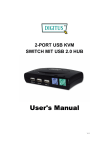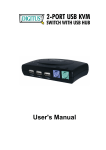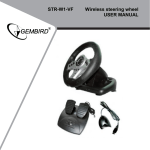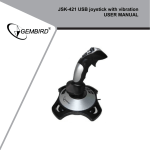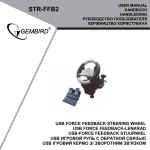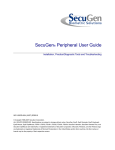Download Cables to Go 35554 Specifications
Transcript
TruLink™ 2-Port VGA USB 2.0/PS2 KVM Switch Model: 35554 Operation Manual Version 1.0 Operation Manual TruLink™2-Port VGA USB 2.0/PS2 KVM Switch Connects two computers to one USB or PS2 keyboard, mouse, and VGA monitor Model: 35554 Thank you for purchasing the TruLink 2-Port VGA USB 2.0/PS2 KVM Switch. We recommend that you read this manual thoroughly and retain for future reference. Function: This KVM Switch offers a quick and easy way to eliminate clutter from your desktop. It can control two computers with just one keyboard, mouse, and VGA monitor. Connect the switch to your computers via USB and VGA by using the included cables. The three downstream USB 2.0 ports can be used to share USB peripherals and your USB mouse and keyboard. Or, connect your keyboard and mouse by using the PS2 ports and use all three downstream USB 2.0 ports for peripherals. Three types of switching (push button, hot keys, and on-screen-display) enable switch operation in the most effective way for your application. Package Contents: • • • • • TruLink 2-Port VGA USB 2.0/PS2 KVM Switch CD with Operation Manual and On-Screen-Display (OSD) Utility Two sets of 1.8M VGA/USB Combo Cables 5V 2A DC Power Supply Printed Operation Manual ii Table of Contents Function...…………………………………………………………………………...ii Package Contents……………………………………………………………….....ii Features……………………………………………………………………………..1 Connecting the (product name here)……………………………………………..1 Windows 98/SE Installation...................................................................1 LED Indicators.......................................................................................3 Operating the (product name here).....…………………………………………....4 Driver/Software Installation....................................................................4 On-Screen-Display (OSD) utility software installation for windows........8 Using OSD Program.............................................................................10 Interpreting the OSD Window................................................................11 Switching the Active Host Using the OSD.............................................12 Hiding and Closing the OSD Program...................................................13 Manual Switch by Push Button..............................................................13 Activating the Autoswitch Function........................................................13 Hot Key Switch.......................................................................................14 OSD Switch (Windows only)..................................................................14 Autoscan Function.................................................................................14 Sun Micro System Function Key Emulation...........................................15 Hot Key Definition Table........................................................................16 Application Notes..............................................................................................17 Troubleshooting…………………………………………………………………......18 Specifications……………………………………………………………………......18 Warranty/Important Safety Information…………………………………………...19 Disclaimer/FCC Statement................................................................................20 iii Features • • • • • • • Controls two PCs with one PS2 or USB keyboard, one PS2 or USB mouse, and one monitor Supports Windows 98/98SE/2000/Me/XP/VISTA, Linux Kernel 2.3 or later, Mac OS9/OSX, Sun Micro Solaris 8 ( SUN BLADE 100) Built-in three port USB 2.0 hub Supports three types of switching: hardware push button, hot keys on PS2 keyboard, and On-Screen-Display (OSD) utility software (for Windows) OSD utility indicates: -Power status of connected computer(s) -Active host computer Supports VGA resolutions up to 2048x1536. Plug and play compatible Connecting the TruLink KVM 1. Connect the USB cable “A” end to the computer’s USB port, and the “B” end to the PC1 USB upstream port on the KVM. 2. Connect the male end of the VGA cable to the VGA port on the computer and the female end of the VGA cable to the PC1 monitor IN port on the KVM. 3. Repeat steps 1 and 2 for the second computer, using the PC2 USB port and PC2 monitor IN port on the KVM. 4. Connect the VGA cable from the monitor to the monitor output port on the KVM. 5. Connect a PS2 keyboard and mouse to the PS2 ports on the KVM or a USB keyboard and mouse to the USB 2.0 hub on the KVM. 6. Turn on the computers and make sure that the USB port is enabled and working properly. Window 98/SE installation: For Window 98 and 98/SE system users, installation is a different from above. After the hardware installed, please follow up these steps to install the KVM switch: 1. Remove PS/2 mouse and Keyboard devices from the TruLink KVM and plug them into the PC 2. Turn ON the PC 3. Use the TruLink KVM push buttons to switch to the target PC with the Windows 98/SE system 4. Follow the Driver installation instructions in the operating instructions section 5. Remove PS/2 mouse and keyboard from PC and plug into the TruLink KVM 1 Diagram of connections: PC 1 USB Reset Button PC 1 Monitor IN PC 2 Monitor IN Side View 2 PC 2 USB DC-5V Power Jack LED Indicators Host Indicators (RED) ON: Host PC is available and active. Flash: Indicates which Host PC is selected but not powered on HUB Switch with PC1/PC2 Indicators (GREEN) Hub Switch with PC1 ON (Green): All USB 2.0 downstream ports are connected to PC1 Hub Switch with PC2 ON (Green): All USB 2.0 downstream ports are connected to PC2 Auto-Switch/Auto-Scan Indicator (GREEN) ON: Auto-Switch mode is active. The USB hub will switch with PC switching. OFF: Auto-Switch mode is inactive. The USB hub switch is independent from PC and can be controlled by hot key. Flash: Auto-Scan mode is active. PC2 HOST (RED) PC1 HOST (RED) HUB switch with PC1(Green) Auto-Switch/ Auto-Scan ( Green ) HUB switch with PC2 ( Green ) 3 Operating the TruLink KVM: Driver/Software installation: No driver is needed for the following operating systems: a. Windows ME/2000/XP b. MAC OS9/OSX c. Linux Kernel 2.3 or above d. Sun Micro Solaris 8 or above Windows 98/98SE: After you connect the TruLink KVM Switch to your PC, Win 98 will automatically detect the device and prompt for the driver installation. Please proceed with the installation of the driver by following the instructions from Step A-H. Please have your Windows 98 CD ready. Step A A. Click “Next” to Continue Step B B. Click “Next” to initiate the search for the best driver for your device. 4 Step C C. Click “Next” to start and search. Step D D. Click “OK” to continue 5 Step E E. Click “Next” to continue Step F F. Please specify the location of the Windows source disk and Click “OK” to continue. You may use “Browse” to locate the driver. (Ref Figure F) *Note: Your hidclass.sys file might be located in a different directory from the figure above. 6 Step G G. Click “OK” to continue Step H H. Click “Finish”, Windows has finished installing the USB Human Interface Device driver for the keyboard & mouse. 7 On-Screen-Display (OSD) utility software installation for windows Place the enclosed CD into your CD-ROM drive. The AutoManual screen will automatically pop up on your monitor. Click the “Install OSD utility” button to proceed. If the AutoManual screen does not present, use the file explorer to choose the CDROM driver, and execute the AutoManual.exe. Step A Click “Next” to continue the installation Step B B. Click “Next” to continue 8 Step C C. Click “Yes” to continue Step D D. Click “Start” to continue Step E E. Click “Exit” 9 Using the OSD Program Activating the OSD program z Click: Start Menu \Program \KVM-OSD\KVM-OSD z OSD will start 10 Interpreting the OSD window The OSD indicates the status of the connections, host PC and the USB device. Port connection status and active host status buttons Close Button Hide Button Host PC status There are four different statuses: A. “No PC Found” indicates no PCs are connected to the TruLink KVM or that connected PCs are off. B. “PC 1 On” indicates the first port has a PC connected to it, the PC is on and the active host. The second port either has NO PC connected to it, or the PC is connected, but not on. 11 C. “PC 2 On” indicates the second port has a PC connected to it, the PC is on and the active host. The first port either has NO PC connected to it, or the PC is connected, but not on. D. Both ports have PCs connected and on. The red letter and larger numeral indicates the second port is the active host. The green letter and smaller numeral indicates that the first port is NOT the active host, but is available for connection. Switching the active host using the OSD program Using the mouse, simply click on the button of the port that you want as the active host. The program will automatically switch the active host and the numbers on the button will change accordingly. 12 Hiding and closing the OSD program z When you click the “Hide” button, OSD program window will hide in the Taskbar. z When you click the “Close” button, OSD program will exit. z If OSD program is hidden in Taskbar, you can right click on the taskbar icon to show or close the program. Manual Switch by push button 1.1 HOST selection You can switch to the next available active PC by pushing the switch button on the TruLink KVM Switch Activating the Auto Switch Function You can activate Auto Switch Function by pushing the switch button for three seconds. The USB hub will switch with the Host when the Auto Switch Function is enabled. 13 Hot Key Switch (PS/2 keyboards only, not available for USB keyboards) [Scroll], [Scroll], [1] or [Scroll], [Scroll], [2] Switch to PC1: Scroll Lock + Scroll Lock + [ 1 ] Switch to PC2: Scroll Lock + Scroll Lock + [ 2 ] Switch to upper host: Scroll Lock + Scroll Lock + ↑ Switch to next host: Scroll Lock + Scroll Lock + ↓ Auto Switch: Scroll Lock + Scroll Lock + [ H ] Note: When using the two-step Hot Key sequences, the keys must be pressed within 3 seconds; otherwise the Hot Key action will be canceled. After pressing the Scroll key twice, the Scroll LED will start blinking and wait for the Step 2 hotkey, after pressing any key or over 3 seconds, the keyboard LED will switch back to the original status. On-Screen-Display (OSD) Switch (Windows only) Activate the OSD and click the port number on the OSD. The active host will change to the indicated port. Auto-Scan Function Activate Autoscan Press Scroll + Scroll + [S] to activate AutoScan Mode. Disable Autoscan Press any key excluding number keys [ 1 ], [ 2 ], [ 3 ] and [ 4 ] to turn off the AutoScan Mode. The KVM will switch back to the original Host. When you activate the Auto-Scan mode, the USB KVM Switch alternates between the two PCs and displays them on the monitor. Each PC can be displayed at 5, 10, 15, or 20 seconds: 14 Auto-Scan Interval [n] *(Available only when Auto-Scan function is ON) You can change the Auto-Scan interval by pressing the appropriate number key or the number pad keys. n [1] [2] [3] [4] Scan Interval 5 sec. 10 sec. 15 sec. 20sec. Sun Micro System Function Key Emulation: There are 16 special functions on the Sun Micro system keyboard, the TruLink KVM can emulate these function keys via the PS/2 keyboard (it won’t work on USB keyboards). Below is the mapping table for these functions. To activate emulation on the PS/2 keyboard, you have to press the LEFT Window KEY first (this key is usually is located between the left [Ctrl] and left [Alt]), then choose the second as required. Sun Micro System Function Key PS/2 Keyboard Stop L_Win & L_Alt Props L_Win & L_Ctrl Compose L_Win & L_Shift Front L_Win & F1 Open L_Win & F2 Find L_Win & F3 Again L_Win & F4 Undo L_Win & F5 Copy L_Win & F6 Paste L_Win & F7 Cut L_Win & F8 Help L_Win & F11 Power L_Win & F12 15 Mute L_Win & 1 Volume Down L_Win & 2 Volume UP L_Win & 3 Hot key definition table Step 1 Step2 Action USB hub Auto-Switch mode Switches access to the computer connected to PC1 Switches access to the computer connected to PC2 Switches to the next connected PC Switches to the upper PC Switches to the next PC Switches the USB Hub to PC1 Switches the USB Hub to PC2 Starts Autoscan Mode * No Scroll Key Need * * * Sets AutoScan time interval to 5 seconds (Available only when Auto-Scan function is ON) Sets AutoScan time interval to 10 seconds (Available only when Auto-Scan function is ON) Sets AutoScan time interval to 15 seconds (Available only when Auto-Scan function is ON) Sets AutoScan time interval to 20 seconds (Available only when Auto-Scan function is ON) 16 Application Notes 1. IMPORTANT: Please select “Safely Remove Hardware” or “Eject” for USB devices connected to any of the 3 downstream USB ports on the TruLink KVM Switch before switching between the hosts. Switching hosts is equivalent of removing the USB devices, which may damage your USB devices or data if not removed properly by the OS. 2. The TruLink KVM normally derives its own power from host computer. When the 2-port USB KVM Switch and the USB port of computer are connected, the LED will turn red, and the keyboard and mouse can operate. 3. Unknown Device: If the installation process has been completed and some of the devices still don't work, please go to: Device Manager, check to see if any “Unknown device” icons appear on the screen. You may need to “Remove” and “Refresh”, then start the installation process again. If after trying the above mentioned process and your device still does not work, please contact your Cables To Go technical support. **Note: If you are connected to a heavy-duty HDD / CD-ROM, ‘unknown device’ might occur. Please plug in the appropriate adapter for power sufficiency. 17 Troubleshooting: Problem Possible Solution Devices don’t work 1. Refer to number 3. in the Application Notes section of this operation manual One or more of my PCs aren’t responsive 1. Make sure that your VGA cables are screwed securely to the KVM terminal Distorted Picture 1. Check your resolution on your computer and be certain it doesn’t exceed the maximum resolution of the KVM. Specifications: Interface Inputs 1. VGA Male-2 2. USB B Female-2 3. PS2 Female- 2 Outputs 1. VGA Female- 1 2. USB 2.0 A Female- 3 2048 X 1536 Video resolution Power 5V 2A DC Weight 5.44lbs 2.25 L x 1 H x 4.75 W inches Dimensions (W x H x D) 18 Cables To Go™ Three Year Warranty At Cables To Go, we want you to be totally confident in your purchase. That is why we offer a three year warranty on this device. If you experience problems due to workmanship or material defect for the duration of this warranty, we will repair or replace this device. To request a Return Merchandise Authorization (RMA) number, contact customer service at 1-800-506-9606 or www.cablestogo.com. Important Safety Information ! Do not plug the unit in any outlet that does not have enough current to allow the switch to function. Refer to the specifications in this manual for power level of the unit. ! Liquid: If this unit or its corresponding power adapter has had liquid spilled on or in it, do not attempt to use the unit. Do not attempt to use this product in an outdoor environment as elements such as rain, snow, hail, etc. can damage the product. ! In case of a storm, it is recommended that you unplug this device from the outlet. ! Avoid placing this product next to objects that produce heat such as portable heaters, space heaters, or heating ducts. ! THERE ARE NO USER SERVICEABLE PARTS Do not attempt to open this product and expose the internal circuitry. If you feel that the product is defective, unplug the unit and refer to the warranty information section of this manual. 19 Disclaimer Information in this document is subject to change without notice. The manufacturer does not make any representations or warranties (implied or otherwise) regarding the accuracy and completeness of this document and shall in no event be liable for any loss of profit or any other commercial damage, including but not limited to special, incidental, consequential, or other damages. No part of this document may be reproduced or transmitted in any form by any means, electronic or mechanical, including photocopying, recording or information recording and retrieval systems without the express written permission of the manufacturer. All brand names and product names used in this document are trademarks, or registered trademarks of their respective holders. FCC Statement This device generates and uses radio frequency and may cause interference to radio and television reception if not installed and used properly. This has been tested and found to comply with the limits of a Class B computing device in accordance with the specifications in Part 15 of FCC Rules. These specifications are designed to provide reasonable protection against such interference in a residential installation. However, there is no guarantee that interference will not occur in a particular installation. If this device does cause harmful interference to radio or television reception, which can be determined by plugging the device in and out, the user can to try to correct the interference by one or more of the following measures: • • • • Reorient or relocate the receiving antenna. Increase the separation between the device and receiver. Connect the computer into an outlet on a circuit different from that to which the receiver is connected. Consult the dealer or an experienced radio/TV technician for help. 20























